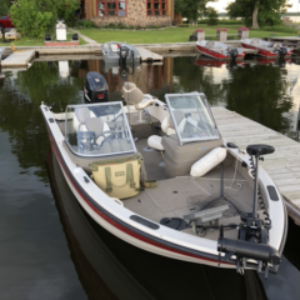Hello…new to the forum so bear with me please! Hopefully this is the right area fo a tech question on my battery setup. I have a 2 year old 16-1/2′ Alumacraft with a 50 HP tiller. The dealer put in a group 24 Northern, starter/combo battery with RC of 95. I added a Helix 9 right away and a 3 bank charger to maintain the two Terrova batts and the starter/combo battery. Everything was good until late last year when I added a Helix 7 up front, also connected to the starter/combo batt and now I’m getting low volt warnings on the finders. I assume the starter/combo battery is just too wimpy for the electronics but I’d like some advice. I do not want to add a fourth battery just for the electronics and definately don’t want to change to a 4 bank charger. This has to be a fairly common problem right? I have room for a group 27 and possibly a group 31…the boats stored right now so I cant verify till spring. Also, I’m a newly retired guy who goes out once, maybe twice a week for a couple hours so I’m not exactly a heavy hitter in the fishing community! What are my best and most practical options?
IDO » Forums » Fishing Forums » General Discussion Forum » Battery setup…need advice
Battery setup…need advice
-
March 9, 2022 at 9:24 am #2106192
I would check what the low battery voltage setting is on your helix units. I have a similar setup to you and helix units like to show that low voltage message mostly when I start the big motor. I have turned my setting down and even off on the Helix because its annoying and it seems to be a momentary voltage drop from cranking over the motor and prompts the message. I could be wrong, but that is my opinion. At least you have the 3 bank charger so that you are topping off all your battery’s every time you plug in that charger.
March 9, 2022 at 9:26 am #2106196I think you’re on the right track. If you can get a 31 series battery in there, I would go that route. If not, a 27 series should improve the situation.
Adding a 4th battery seems like serious overkill in your situation.
March 9, 2022 at 9:33 am #2106203See if you can find an Interstate 27M-XHD, 182 Rc rating.
https://www.interstatebatteries.com/products/27m-xhd?productline=marine
HRG
March 9, 2022 at 9:34 am #2106204Before you replace batteries, check to make sure the wire run to the Helix units is properly sized for the current requirement of the unit and the distance of the run.
DC current is HIGHLY susceptible to resistance over the length of a wire run. Wire HAS to be correctly sized for run length and current draw.
My guess is your wire is undersized and as soon as the batter gets drawn down a litle, the unit can’t suck enough juice through the too-small straw.
This is a common problem with today’s boats and electronics.
March 9, 2022 at 9:37 am #2106206Thanks…I too have wondered if the low volt alarm is accurate and agree it can be annoying but so is limpimg back to the landing on the troller if the engine won’t start! I have not experienced the low volt waring when cranking the outboard though. I’m sure it does when cranking but I’m experiencing it when not under power…either floating, anchored or trolling with the Terrova. That’s the other thing…I hammer to a fishing spot on the outboard, kill it and mostly use the troller, so there’s very little run time on the outboard to charge up the battery.
 CaptainMusky
Posts: 19233March 9, 2022 at 9:42 am #2106208
CaptainMusky
Posts: 19233March 9, 2022 at 9:42 am #2106208Do you have the depth finders wired through a switch? Sometimes that is the cause because there may be a lot of other items running through that same switch drawing down the voltage. I have run into this as well. I have two units at the console and if I run them both one of them flakes out unless I have the outboard running. I actually added a second battery in the back and run all electronics off the one.
 mnfisherman18
Posts: 344March 9, 2022 at 9:47 am #2106214
mnfisherman18
Posts: 344March 9, 2022 at 9:47 am #2106214Group 24 is probably borderline for that setup. I bought a 27 with the highest RC I could find and its fine running a Hellix 10 & 7 for extended periods.
March 9, 2022 at 9:49 am #2106220Here’s the sad part…I’m a retired master electrician who worked in a supervisory capacity in the commercial construction field for 40+ years! I’m asking electrical questions! I know the Helix 9 at the “helm” is run in #12 “extension wires” to the factory harness on the unit. I’m guessing those extensions (+/-) are maybe 12-15″ long directly off the battery. I know I complied with the Humminbird specs on that guage wire, but I could poop those up to #10 fairly easy. The Helix 7 added up front is hooked up to the factory wires Alumacraft had installed there and I think they’re #12 but I can’t say for sure. I’ll do some recon in a month or so (hopefully not too much longer) and cover my bases accordingly. Either way I will be increasing the battery size as a way to hedge my bet.
 MX1825
Posts: 3001March 9, 2022 at 10:22 am #2106243
MX1825
Posts: 3001March 9, 2022 at 10:22 am #2106243Many battery brands also have a group 29 battery that has more RC. It is usually just a quarter inch longer than a group 27.
March 9, 2022 at 10:27 am #2106245To answer Capt Musky…no switches. Both are wired directly to the battery (fused of course).
 Stanley
Posts: 788March 9, 2022 at 10:34 am #2106253
Stanley
Posts: 788March 9, 2022 at 10:34 am #2106253I would check the power wire with a volt meter as well to see what is actually there for power instead of relying on the helix unit. On my old boat I had 2 helix 9’s, one was a g1 the other g2. I kept getting a low voltage warning as well so I went from a group 24 to group 31agm battery and was still having low voltage issues. When I had both locators on at the same time there would be .5-1 volt difference between the two. The bow locator had the higher volt reading. When I checked the power wire for my counsel locator it read 1 volt higher than what my screen showed. After that I just lowered my alarm and added 1 volt to what my helix said. Never had a issue running out of power.
 Benny
Posts: 54March 9, 2022 at 1:41 pm #2106332
Benny
Posts: 54March 9, 2022 at 1:41 pm #2106332I think you’re wiring is sufficient, you likely just need a bigger battery. A group 24 is pretty small. I used #12 to wire my bow unit (Helix 9) and I have no issues with voltage. I wired both my Helix 9s to the fuse panel but I have a #8 wire feeding that from the battery.
If it makes you feel better, my dealer also dropped a Group 24 in my Tyee when I bought it. I took that thing out right away and replaced with a dual purpose marine Group 31. I can spend days up in Voyageurs with no access to plug in the charger and haven’t had a problem with it getting low on me (includes some buzzing around, motor has a good sized alternator).
 duh queen
Posts: 547March 9, 2022 at 2:06 pm #2106354
duh queen
Posts: 547March 9, 2022 at 2:06 pm #2106354I added a new Garmin locator last spring and suddenly my cranking battery was running low. Those newer sonars really suck up a lot of power.
 CaptainMusky
Posts: 19233March 9, 2022 at 2:14 pm #2106357
CaptainMusky
Posts: 19233March 9, 2022 at 2:14 pm #2106357To answer Capt Musky…no switches. Both are wired directly to the battery (fused of course).
Be aware that the internal GPS is always powered even if the unit isnt on. This will put a drain on your battery without a master power switch.
March 9, 2022 at 6:01 pm #2106450Thanks for all the advice. Upsizing the battery is my first task come spring. I’ll verify wiring methods are up to snuff as well.
March 9, 2022 at 6:18 pm #2106456What is the low voltage warning setting on the Helix set to.
My motor manufacturer suggested 11.5 volts.March 11, 2022 at 6:40 am #2106901Would highly recommend a second battery. Going up one battery size will not deliver the capacity if you are a hard fish guy. I tried this only to eventually use a add a battery kit from blue sea and two 31 batteries. Should be in your wheel house if you are an electrician like I am. Reach out if you have any questions. Here is a link to this site.
March 11, 2022 at 7:22 am #2106909Going up one battery size will not deliver the capacity if you are a hard fish guy.
To quote the OP:
Also, I’m a newly retired guy who goes out once, maybe twice a week for a couple hours so I’m not exactly a heavy hitter in the fishing community!
March 11, 2022 at 8:47 am #2106930I think the default low voltage on the Helix series is 12 volts.
This is probably way too high for your motor.
And will be reached in a much shorter amount of time (hours shorter) than 11.5
My 4 stroke Mercury manufacturer support said I should use 11.5
They responded to my inquiry in about 4 hours (pre covid)March 11, 2022 at 9:54 am #2106950For the new battery just get an AGM in the largest size you can fit. It doesn’t need to be dual purpose. Marine deep cycle AGM batteries have more cranking amps than you will ever need. And it can handle your deep cycle needs better. Deep cycle batteries can handle draw downs better. That alone extends the life of the battery when you are powering electronics too.
I have a rebranded group 31 NorthStar deep cycle. It powers 3 helix 12 units, stereo w. powered sub, bilge pumps and livewell pumps. Never had a problem starting the F250. The humminbirds don’t shut down when I do start it.
You must be logged in to reply to this topic.